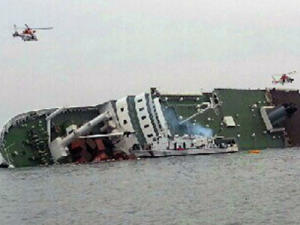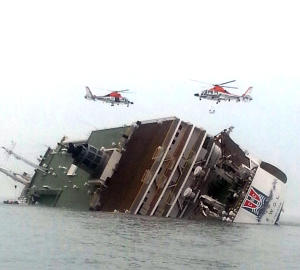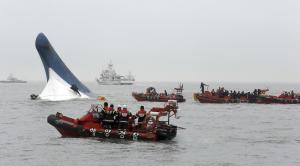SEOUL, South Korea (AP) — A ferry
carrying 459 people, mostly high school students on an overnight trip
to a tourist island, sank off South Korea's southern coast on Wednesday,
leaving nearly 300 people missing despite a frantic, hours-long rescue
by dozens of ships and helicopters. At least four people were confirmed
dead and 55 injured.
The high number
of people unaccounted for — likely trapped in the ship or floating in
the ocean — raised fears that the death toll could rise drastically,
making it one of South Korea's biggest ferry disasters since 1993, when
292 people died.
One student,
Lim Hyung-min, told broadcaster YTN after being rescued that he and
other students jumped into the ocean wearing life jackets and then swam
to a nearby rescue boat.
"As
the ferry was shaking and tilting, we all tripped and bumped into each
another," Lim said, adding that some people were bleeding. Once he
jumped, the ocean "was so cold. ... I was hurrying, thinking that I
wanted to live."
Local
television stations broadcast live pictures of the ship, Sewol, listing
to its side and slowly sinking as passengers jumped out or were winched
up by helicopters. At least 87 vessels and 18 aircraft swarmed around
the stricken ship. Rescuers clambered over its sides, pulling out
passengers wearing orange life jackets. But the ship overturned
completely and continued to sink slowly. Within a few hours only its
blue-and-white bow stuck out of the water. Very soon, that too
disappeared.
Some 160 coast
guard and navy divers searched for survivors inside the ship's wreckage a
few kilometers (miles) from Byeongpung Island, which is not far from
the mainland. The area is about 470 kilometers (290 miles) from Seoul.
Those rescued — wet,
stunned and many without shoes — were brought to nearby Jindo Island,
where medical teams wrapped them in pink blankets and checked them for
injuries before settling them down on the floor of a cavernous gymnasium
hall.
The ship had set sail
from Incheon, a city in South Korea's northwest and the site of the
country's main international airport, on Tuesday night for an overnight,
14-hour journey to the tourist island of Jeju.
Three
hours from its destination, the ferry sent a distress call at about 9
a.m. Wednesday after it began listing to one side, according to the
Ministry of Security and Public Administration. Officials didn't know
what caused it to sink and said the focus was still on rescuing
survivors.
Lee Gyeong-og, a
vice minister for South Korea's Public Administration and Security
Ministry, said 30 crew members, 325 high school students, 15 school
teachers and 89 non-student passengers were aboard the ship.
Kang
Byung-kyu, a government minister, said two of the dead were a female
crew member and a male high school student. He said a third body was
also believed to be that of a student. A coast guard officer confirmed a
fourth fatality but had no immediate details about it.
Kang said 164 people were rescued, of whom 55 were injured. Officials said 292 people were missing.
Yonhap
news agency said the 146-meter (480-foot) -long ship, which travels
twice a week between Incheon and Jeju, was built in Japan in 1994 and
could carry a maximum of 921 people, 180 vehicles and 152 shipping
containers.
The water
temperature in the area was about 12 degrees Celsius (54 Fahrenheit),
cold enough to cause signs of hypothermia after about 1½ hours of
exposure, according to an emergency official who spoke on condition of
anonymity citing department rules. Officials said mud on the ocean floor
made underwater search operations difficult. Lee, the vice minister,
said the ocean is 37 meters (121 feet) deep in the area.
Passenger
Kim Seong-mok told YTN that he was certain that many people were
trapped inside the ferry as water quickly rushed in and the severe tilt
of the vessel kept them from reaching the exits. Some people urged those
who couldn't get out to break windows.
Kim said that after having
breakfast he felt the ferry tilt and then heard it crash into
something. He said the ferry operator made an announcement asking that
passengers wait and not move from their places. Kim said he didn't hear
any announcement telling passengers to escape.
The students — half of them
boys and half girls— are from Danwon High School in Ansan city, which
is near Seoul, and were on their way to Jeju island for a four-day trip,
according to a relief team set up by Gyeonggi province, which governs
the city. There are faster ways to get to Jeju, but some people take the
ferry from Incheon because it is cheaper than flying. Many South Korean
high schools organize trips for students in their first or second
years, and Jeju is a popular destination. The students on the ferry were
in their second year, which would make most of them 16 or 17.
At the high school, students were sent home and parents gathered for news about the ferry.
Park
Ji-hee, a first-year student, said she saw about a dozen parents crying
at the school entrance and many cars and taxis gathered at the gate as
she left in the morning.
She
said some students in her classroom began to cry as they saw the news on
their handsets. Teachers tried to soothe them, saying that the students
on the ferry would be fine.
The
Maritime Ministry said the two previous deadliest ferry disasters were
in 1970 when 323 people drowned and in 1993 when 292 people died.



No comments:
Post a Comment